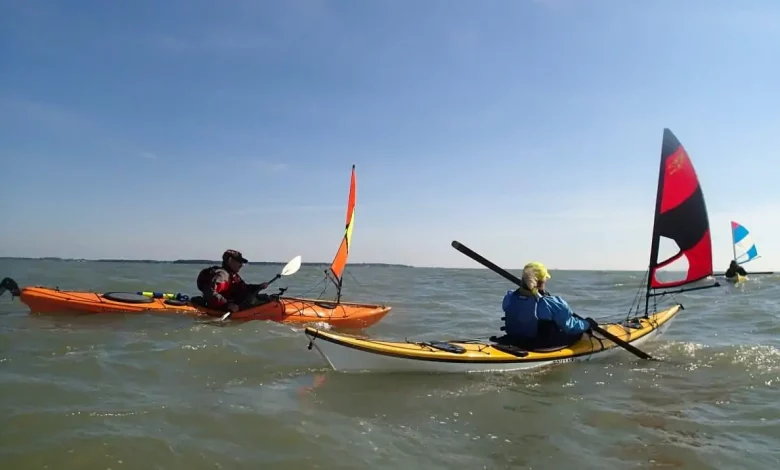Kayak Sailing Adventures: Harnessing the Power of the Wind

Welcome to the thrilling world of Kayak Sailing Adventures! If you’ve ever wondered about the exhilarating blend of kayaking and sailing, you’re in the right place. Kayak sailing is a unique water sport that combines the tranquility of kayaking with the dynamic force of the wind. Let’s delve into the definition and concept of this exciting activity.
What is Kayak Sailing?
Kayak sailing involves fitting a sail to a kayak, allowing it to harness the wind’s power for propulsion. Unlike traditional kayaking, where paddlers rely solely on muscle power, kayak sailing introduces an entirely new dimension of exploration and excitement. Picture yourself gliding effortlessly across the water, propelled by the gentle push of the wind.
How does it Differ from Traditional Kayaking?
While traditional kayaking demands physical endurance and skill in maneuvering with paddles, kayak sailing relies on harnessing the wind. This variation not only adds an extra element of speed but also allows for longer journeys with less exertion. Kayak sailing is a versatile and accessible water sport suitable for both beginners and experienced water enthusiasts.
Getting Started with Kayak Sailing
Embarking on a kayak sailing adventure requires proper equipment and mastering basic skills. Let’s explore the essential elements that will set you on the right course.
Essential Equipment
Sail Types and Designs: There are various sail types and designs available for kayak sailing, each influencing performance differently. From downwind sails for beginners to more advanced square sails for experienced sailors, choosing the right sail is crucial.
Choosing the Right Kayak: Not all kayaks are suitable for sailing. Look for kayaks with a stable design, preferably with a flat hull, to accommodate the added dynamics of sailing. Sit-on-top kayaks are often favored for their stability and ease of use.
Safety Gear: Safety should always be a priority. In addition to the standard kayaking safety gear, consider additional items such as a personal flotation device (PFD), a whistle, and a marine-grade compass.
Choosing the Perfect Location
Selecting the right location for your kayak sailing adventure is a pivotal decision that can significantly impact your overall experience. Consider the following factors when scouting for the perfect spot:
Factors to Consider
Wind Conditions: The primary factor for an exceptional kayak sailing experience is the wind. Choose locations known for consistent and predictable winds, ensuring a smooth and enjoyable journey. Coastal areas and large bodies of water often provide ideal conditions.
Water Conditions: Assess the water conditions of your chosen location. Calm and sheltered waters are preferable for beginners, while more advanced sailors might seek out locations with moderate waves and currents to add an extra thrill to their adventure.
Scenic Views and Wildlife: Enhance your kayak sailing experience by selecting locations with breathtaking scenery and diverse wildlife. Coastal areas often offer stunning landscapes, and you may encounter marine life such as dolphins, seals, or seabirds during your journey.
Safety Measures and Precautions
Ensuring your safety on the water is paramount in any water sport, and kayak sailing is no exception. Take the following precautions to make your adventure enjoyable and risk-free:
Weather Considerations
Wind Strength and Direction: Before setting out, check the wind strength and direction. Avoid sailing in strong winds, especially if you’re a beginner, as it can lead to challenging conditions and potential safety hazards. Always plan your route with the wind in mind.
Checking Weather Forecasts: Stay informed about weather forecasts for your chosen location. Sudden changes in weather conditions can occur, so regularly monitor forecasts leading up to and during your kayak sailing adventure.
Emergency Preparedness: Be prepared for unexpected situations. Carry a first aid kit, communication devices (such as a waterproof VHF radio or a mobile phone in a waterproof case), and know the emergency procedures for the area you’re exploring.
Popular Kayak Sailing Destinations
Now that you’re equipped with the knowledge of essential skills and safety measures, let’s explore some breathtaking kayak sailing destinations that offer unique experiences and challenges.
Coastal Adventures
Exploring Seaside Landscapes: Coastal areas are a natural playground for kayak sailors. Navigate through hidden coves, archipelagos, and sea caves, witnessing stunning landscapes along the way. The coastal environment provides a dynamic backdrop for your sailing journey.
Coastal Wildlife Encounters: One of the joys of kayak sailing is the opportunity to observe marine life up close. Coastal areas are often rich in biodiversity, offering encounters with dolphins, seals, seabirds, and even whales. Exercise caution and maintain a respectful distance to avoid disturbing the wildlife.
Challenges and Rewards: Coastal kayak sailing presents its own set of challenges, such as navigating tidal currents and dealing with changing wind patterns near the shore. Overcoming these challenges, however, brings a sense of accomplishment and adds to the overall adventure.
Kayak Sailing vs. Traditional Sailing
To fully appreciate the uniqueness of kayak sailing, let’s compare it to traditional sailing and explore the advantages and disadvantages of each.
Advantages and Disadvantages
Maneuverability and Flexibility: Kayak sailing excels in maneuverability, allowing sailors to navigate tight spaces and explore areas inaccessible to larger sailboats. The flexibility of kayaks makes them suitable for exploring narrow channels and winding rivers.
Skill Level Required: While traditional sailing often demands a steep learning curve and extensive training, kayak sailing is more accessible to beginners. The basic skills required for kayak sailing can be learned relatively quickly, providing a quicker entry point into the world of sailing.
Equipment Comparison: Kayak sailing requires less equipment and is generally more cost-effective than traditional sailing. Kayaks are easier to transport, store, and maintain, making them a practical choice for those who want a sailing experience without the complexities associated with larger sailboats.
Personal Stories and Experiences
To bring the world of kayak sailing to life, let’s delve into personal stories and experiences shared by seasoned kayak sailors. Their insights, adventures, and lessons learned provide valuable guidance for both beginners and experienced enthusiasts.
Interviews with Kayak Sailors
Memorable Adventures: Hear firsthand accounts of kayak sailing adventures that left a lasting impression. From navigating challenging conditions to discovering hidden gems along the coast, these stories showcase the diverse experiences that kayak sailing offers.
Lessons Learned: Experienced kayak sailors often share valuable lessons learned through trial and error. Discover tips on reading wind patterns, choosing the right equipment, and overcoming unexpected challenges. Learning from others’ experiences can enhance your own sailing journey.
Tips for Beginners: Gather advice for beginners entering the world of kayak sailing. From selecting the right location for initial outings to honing essential skills, these tips provide a roadmap for those taking their first steps into this exciting water sport.
Maintenance and Care
To ensure the longevity of your kayak sailing equipment, proper maintenance and care are essential. Let’s explore the key aspects of keeping your gear in top condition.
Proper Storage
Cleaning and Maintenance Tips: After each sailing adventure, rinse your kayak, sail, and other equipment with fresh water to remove salt and debris. Inspect the sail for any signs of wear or damage, and address issues promptly to prevent further deterioration.
Longevity of Equipment: With regular maintenance, kayak sailing equipment can provide years of enjoyment. Proper storage, routine inspections, and timely repairs contribute to the longevity of your kayak and sail, ensuring they remain reliable for future adventures.
Common Issues and Solutions: Familiarize yourself with common issues kayak sailors may encounter, such as wear on the sail, damage to the kayak hull, or issues with the rigging. Knowing how to address these issues will empower you to keep your equipment in peak condition.
Environmental Impact and Responsible Kayak Sailing
As lovers of the great outdoors, it’s crucial for kayak sailors to adopt practices that minimize their environmental impact. Let’s explore how you can enjoy kayak sailing responsibly and contribute to the preservation of our natural surroundings.
Leave No Trace Principles
Minimizing Your Environmental Footprint: Embrace the “Leave No Trace” principles, ensuring you leave the environment as you found it. Pack out all waste, including trash and any items brought along for the journey. Be mindful of delicate ecosystems and avoid disturbing flora and fauna.
Wildlife Conservation: Respect wildlife by observing from a distance and avoiding direct interaction. Kayak sailing offers unique opportunities to appreciate marine life without causing distress. Follow guidelines and regulations for wildlife viewing in each specific area.
Responsible Recreation Practices: Follow established waterway regulations and respect any restricted areas. Avoid disturbing nesting birds or fragile habitats. Consider joining local environmental initiatives or cleanup efforts to give back to the places you explore.
Conclusion
Embarking on a kayak sailing adventure is not just about the thrill of the wind and water it’s a journey of self-discovery, appreciation for nature, and responsible outdoor recreation. By mastering essential skills, choosing the right locations, and prioritizing safety and environmental consciousness, you can make the most of your kayak sailing experiences.









